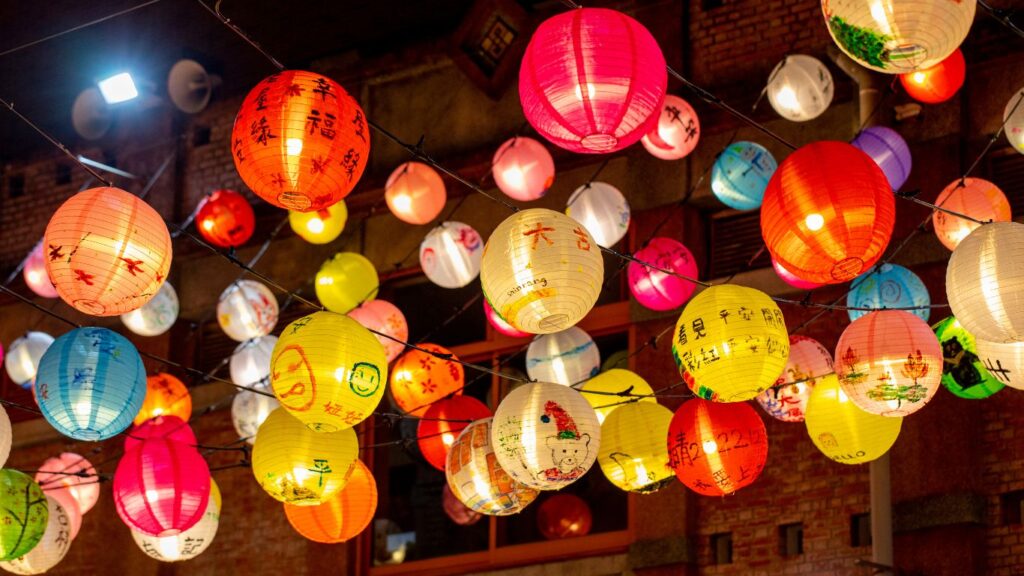Are you puzzled about the symbolism and significance of colors in Chinese culture? You’re not alone. Chinese culture’s color has rich and deep meanings, even relating to luck and prosperity.
This article will demystify these beautiful hues for you, sharing insights about the cultural importance attached to different shades. Intrigued yet? Dive in and discover your favorite color’s meaning!
Key Takeaways
- Chinese colors hold significant meanings in the culture, with red symbolizing luck and joy, orange representing enthusiasm and creativity, yellow signifying prosperity and power, green representing harmony and growth, blue symbolizing immortality and stability, purple representing spirituality and mystery, white symbolizing purity and mourning, black signifying power and authority.
- Red is a very important color in Chinese culture, representing strength, energy, happiness, and good luck. Yellow is associated with royalty and power. Green symbolizes growth, harmony, and vitality, while blue represents calmness but also sorrow. Purple stands for spirituality & nobility. White signifies purity & death, while black represents formality & sadness.
- It’s essential to understand the cultural significance of colors when marketing: Use red sparingly for special occasions or celebrations. Replace white with other colors to avoid negative associations related to death or bad luck. Use green thoughtfully since having a “green face” can signify anger or jealousy in Chinese culture.
- By embracing the symbolism behind Chinese colors, we can appreciate their depth of meaning within the culture and use them strategically in various aspects of life – from design to marketing – to create meaningful connections with a Chinese audience.
Table of Contents
The Meaning of Chinese Colors
Chinese colors hold significant meanings in the culture, with red symbolizing luck and joy, orange representing enthusiasm and creativity, yellow signifying prosperity and power, green representing harmony and growth, blue symbolizing immortality and stability, purple representing spirituality and mystery, white symbolizing purity and mourning, black signifying power and authority.
Red
Red is a key color. It stands for life and energy. People see it as a lucky color that brings joy. It shows up often during special times, and gifts are wrapped in red paper.
Gold goes well with red too. They form a rich mix of colors on happy days like Chinese New Year or weddings.
Orange
Orange is not traditionally considered a significant color in Chinese culture, but it does have some associations. In general, the orange represents good luck and fortune. It is also connected to the autumn season and harvest time.
In terms of symbolism, orange can represent happiness, joy, and warmth. While not as prominent as red or yellow, orange can still evoke positive feelings in specific contexts.
So if you’re looking for a color that symbolizes luck and happiness in Chinese culture, consider using orange!
Yellow
In Chinese culture, yellow is considered a symbol of royalty and power. It represents the authority of the imperial throne and is often used in imperial settings. Yellow is also associated with happiness and good fortune.
However, it’s important to note that during ancient times, only the emperor was allowed to wear yellow clothing as it was considered a color reserved for him. Today, yellow is still highly regarded in Chinese culture and is commonly used in traditional festivals and celebrations.
Its bright and vibrant nature brings joy and positivity to various aspects of life.
Green
Green is a significant color in Chinese culture and represents growth, harmony, and balance. It symbolizes vitality and renewal. However, it’s important to note that having a green face is associated with anger or jealousy in Chinese culture.
Similarly, if a man wears a green hat, it can be seen as a symbol of infidelity. Nonetheless, green is considered an auspicious color that brings good luck and prosperity when used appropriately and in the proper context.
In Chinese culture, it is one of the top three lucky colors, along with red and yellow.
Blue
Blue is not as significant in Chinese culture compared to other colors. While it may represent calmness and tranquility, it is also associated with sorrow and mourning. In traditional Chinese culture, blue is often avoided during festive occasions or celebrations because it symbolizes sadness.
However, blue is becoming more popular and can be seen in clothing, decorations, and design. Despite its mixed meanings, blue still holds a place in Chinese culture but lacks the same level of significance as other colors, such as red or yellow.
Purple
Purple is a color that holds special significance in Chinese culture. It is often associated with spirituality, mystery, and wisdom. In ancient times, purple was considered the color of emperors and represented nobility and power.
Purple is also linked to romance and love, symbolizing passion and elegance. Today, purple is commonly used in festivals and celebrations to add a touch of grandeur and sophistication.
So if you want to embrace the rich cultural traditions, incorporating purple into your designs or decorations can help create an atmosphere of enchantment and beauty.
White
White is a color that symbolizes purity, innocence, and mourning in Chinese culture. It is often associated with funerals and is considered a color of mourning. White represents death and the afterlife, so avoiding using white on celebratory or joyful occasions is essential.
In Chinese weddings, for example, brides traditionally wear red instead of white to avoid any association with bad luck or death. White can also be seen as a neutral color without specific positive or negative connotations.
Black
Black is a color that holds various meanings in Chinese culture. While it may be associated with mourning and sadness, it also represents power, knowledge, and transformation. Black is often used in calligraphy and ink paintings to symbolize wisdom and depth.
In traditional Chinese culture, black was worn by scholars and officials as a sign of status and intelligence. It is considered a neutral color that can add elegance and sophistication to designs or clothing.
However, it’s important to note that black should be used sparingly as too much can create a somber or negative atmosphere.
Gray
Gray is not traditionally considered a lucky color in Chinese culture. It is often associated with sadness and mourning. It symbolizes loss and can be seen as a dull and lifeless color.
Gray is not commonly used in celebrations or joyful occasions. Instead, vibrant and auspicious colors like red, yellow, green, and gold are favored. While gray may have its beauty, it does not hold the same positive connotations as other colors in Chinese culture.
Brown
Brown is not traditionally considered a lucky color in Chinese culture. It has no specific symbolism or significant meaning attached to it in the same way as other colors like red, yellow, or green.
In Chinese culture, brown is more commonly associated with the earth and natural elements. It represents stability, reliability, and simplicity. While it may not be as prominent as other colors in Chinese culture, brown can still be used effectively in design and art to create a sense of warmth and grounding.
Significance of Lucky Chinese Colors
Specific colors are considered to bring luck and good fortune. These Chinese colors hold deep cultural significance, from the vibrant red symbolizing prosperity to the tranquil blue representing harmony.
Discover more about the lucky colors in Chinese culture and how they can be used in various contexts.
Red
Red is a very important color in Chinese culture. It represents strength, energy, and vitality. Red is also associated with happiness and good luck. It is considered an auspicious color often used during festivals and celebrations.
You will see red lanterns hanging up and red envelopes being given as gifts during Chinese New Year. Red is a vibrant and eye-catching color that holds great cultural significance.
Yellow
Yellow is another crucial color in Chinese culture. It is associated with royalty and power, specifically the authority of the throne. In imperial settings, yellow was often used to represent prestige and honor.
However, it’s worth noting that yellow can also carry negative connotations in some contexts. For example, having a “yellow face” in Chinese culture signifies jealousy or anger. Yellow is not as commonly seen as red or green in traditional Chinese festivals and celebrations, but its historical significance cannot be overlooked.
Green
Green is another essential color in Chinese culture and holds significant symbolism. It represents growth, harmony, and balance. In Chinese culture, green is considered an auspicious color that brings vitality and renewal.
However, it’s important to note that having a green face signifies anger or jealousy in Chinese culture. Similarly, if a man wears a green hat, it’s seen as a symbol of infidelity.
Green is among the top three lucky Chinese colors, along with red and yellow. These colors bring happiness, success, good fortune, and prosperity. So when using green in marketing strategies or cultural contexts, it’s essential to be aware of its positive connotations while understanding any negative associations related to this color.
Blue
Blue is a color that holds significance in Chinese culture. It symbolizes immortality, calmness, and depth. In traditional Chinese art and literature, blue represents the sky or water, highlighting its association with peace and tranquility.
Blue is also considered a spiritual color that helps with mental clarity and introspection. However, it’s important to note that in some contexts, having a “blue face” can mean being sad or depressed.
Overall, blue carries positive and negative connotations in Chinese culture but is mainly seen as a soothing color with meaningful symbolism.
Significance of Unlucky Chinese Colors
White is considered an unlucky color in Chinese culture, often associated with death and mourning. Curious to learn about other colors with negative meanings? Keep reading!
Black
Black is a color with different meanings in Chinese culture. On the one hand, it represents formality, dignity, and power. It is often associated with authority figures such as judges or government officials.
On the other hand, black can also symbolize sadness and mourning. In Chinese funerals, people traditionally wear black to show respect for the deceased. So while black can be seen as a powerful and formal color, it’s essential to understand its context to interpret its meaning correctly in Chinese culture.
White
White is a color with different meanings in Chinese culture. It symbolizes purity, cleanliness, and innocence. White is often associated with weddings and funerals. During weddings, the bride usually wears a white dress to represent purity and new beginnings.
On the other hand, white is also the color of mourning in Chinese culture. People wear white clothes during funeral ceremonies to show respect for the deceased. However, it’s important to note that white can also be seen as an unlucky color because it represents death and is associated with bad luck.
So when using colors in marketing strategies, it’s better to replace white with other colors to avoid negative connotations or misunderstandings.
Lucky or Neutral Chinese Colors with negative meanings
While there are lucky colors in Chinese culture, some have negative meanings. For example, white is associated with mourning and funerals. It is essential to avoid using too much white in marketing materials or designs if you want to appeal to a Chinese audience.
Additionally, Chinese culture sees black as a color of bad luck and negativity. Gray is also considered a dull color that lacks vibrancy. So when considering color choices for your brand or marketing strategies targeted toward a Chinese audience, it’s essential to be aware of the cultural meanings behind specific colors and their potential negative connotations.
Tips for Using Chinese Colors in Marketing Strategies
Use red sparingly, consider replacing white with other colors, and use green in the proper context. Discover more tips for effectively using colors in Chinese marketing strategies.
Don’t go overboard with red
Red is a significant color in Chinese culture, symbolizing luck, prosperity, and happiness. However, it’s essential not to use too much red in your marketing strategies. While red is considered auspicious, using excessive red can appear overwhelming or aggressive.
It’s best to use red strategically and balance it with other colors to create a harmonious and visually appealing design. By incorporating other colors that have positive meanings in Chinese culture, you can create a well-rounded and culturally appropriate marketing strategy that resonates with your target audience.
Replace white with other colors
In Chinese culture, white has negative connotations and is associated with death, mourning, and funerals. It is considered unlucky and should be avoided in marketing strategies or any other context where you want to create a positive impression.
Instead, choose other more favorable colors in Chinese culture, such as red, which symbolizes luck and good fortune. Green represents growth and balance, while blue signifies trustworthiness and stability.
By using these Chinese colors instead of white, you can better appeal to your target audience and show respect for their cultural beliefs.
Green is okay, but in the proper context
Green is considered an auspicious color in Chinese culture, symbolizing growth, harmony, and balance. However, it’s important to use green in the proper context because certain expressions related to green have negative meanings.
For example, having a “green face” signifies anger or jealousy, and a man wearing a “green hat” is associated with infidelity. Despite these cultural nuances, green can bring positive energy and renewal to various aspects of life when used appropriately.
Conclusion on Chinese Colors
Discovering the meaning and symbolism behind Chinese colors opens the door to understanding this rich culture. Each color is significant, from the vibrant red representing strength and celebration to the auspicious yellow symbolizing power and authority.
By embracing these cultural associations, we can appreciate the depth of Chinese traditions and use colors strategically in various aspects of life, from design to marketing. Explore the beauty of Chinese color symbolism and let it inspire your colorful journey!
Read More about Chinese Culture
FAQs
- What are some popular Chinese colors?
Popular Chinese colors include red, symbolizing luck and happiness; yellow, representing the Emperor and prosperity; and gold, signifying wealth and fortune.
- Are there any cultural meanings associated with Chinese colors?
Yes, Chinese colors often have cultural meanings attached to them. For example, red is considered a lucky color during festivals and celebrations.
- How can I incorporate Chinese colors into my daily life?
You can incorporate Chinese colors into your daily life by wearing clothing or accessories in traditional Chinese hues, decorating your home with these colors, or using them in art projects.
- Are there any taboos when it comes to using specific Chinese colors?
In Chinese culture, white is associated with mourning or funerals and should be avoided for festive occasions. Black is also seen as somber, while green is linked to infidelity or cheating.








